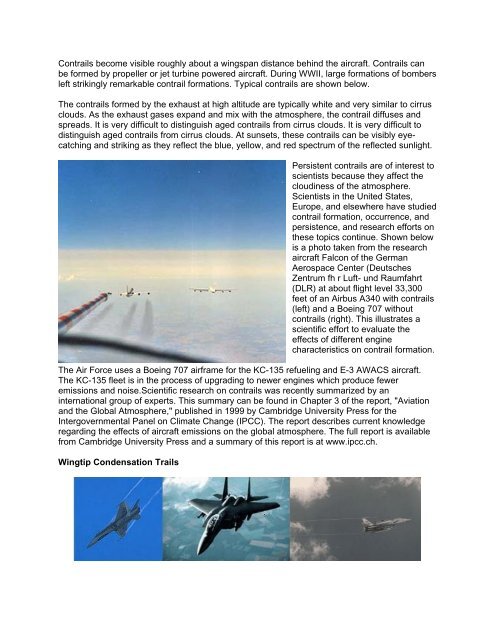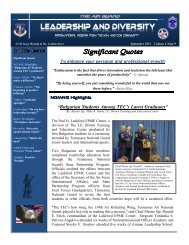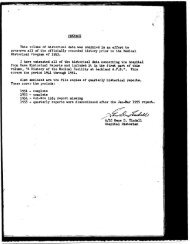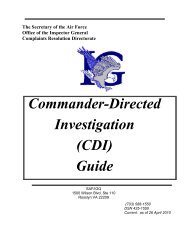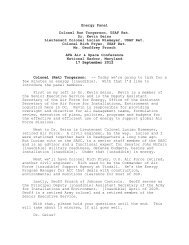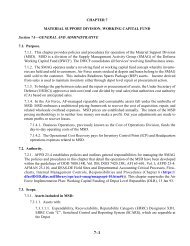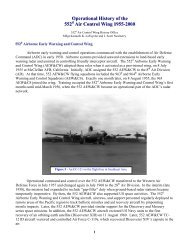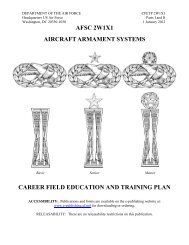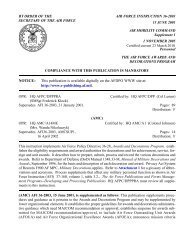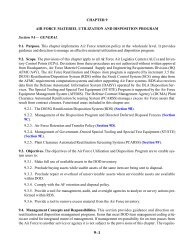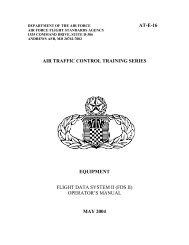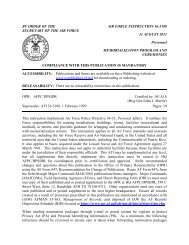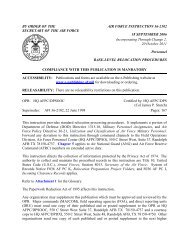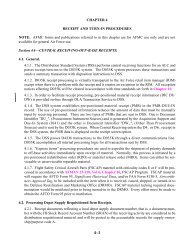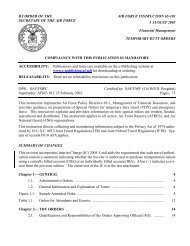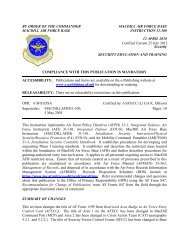CONTRAILS FACTS - Air Force Link
CONTRAILS FACTS - Air Force Link
CONTRAILS FACTS - Air Force Link
- TAGS
- contrails
- link
- www.af.mil
You also want an ePaper? Increase the reach of your titles
YUMPU automatically turns print PDFs into web optimized ePapers that Google loves.
Contrails become visible roughly about a wingspan distance behind the aircraft. Contrails can<br />
be formed by propeller or jet turbine powered aircraft. During WWII, large formations of bombers<br />
left strikingly remarkable contrail formations. Typical contrails are shown below.<br />
The contrails formed by the exhaust at high altitude are typically white and very similar to cirrus<br />
clouds. As the exhaust gases expand and mix with the atmosphere, the contrail diffuses and<br />
spreads. It is very difficult to distinguish aged contrails from cirrus clouds. It is very difficult to<br />
distinguish aged contrails from cirrus clouds. At sunsets, these contrails can be visibly eyecatching<br />
and striking as they reflect the blue, yellow, and red spectrum of the reflected sunlight.<br />
Persistent contrails are of interest to<br />
scientists because they affect the<br />
cloudiness of the atmosphere.<br />
Scientists in the United States,<br />
Europe, and elsewhere have studied<br />
contrail formation, occurrence, and<br />
persistence, and research efforts on<br />
these topics continue. Shown below<br />
is a photo taken from the research<br />
aircraft Falcon of the German<br />
Aerospace Center (Deutsches<br />
Zentrum fh r Luft- und Raumfahrt<br />
(DLR) at about flight level 33,300<br />
feet of an <strong>Air</strong>bus A340 with contrails<br />
(left) and a Boeing 707 without<br />
contrails (right). This illustrates a<br />
scientific effort to evaluate the<br />
effects of different engine<br />
characteristics on contrail formation.<br />
The <strong>Air</strong> <strong>Force</strong> uses a Boeing 707 airframe for the KC-135 refueling and E-3 AWACS aircraft.<br />
The KC-135 fleet is in the process of upgrading to newer engines which produce fewer<br />
emissions and noise.Scientific research on contrails was recently summarized by an<br />
international group of experts. This summary can be found in Chapter 3 of the report, "Aviation<br />
and the Global Atmosphere," published in 1999 by Cambridge University Press for the<br />
Intergovernmental Panel on Climate Change (IPCC). The report describes current knowledge<br />
regarding the effects of aircraft emissions on the global atmosphere. The full report is available<br />
from Cambridge University Press and a summary of this report is at www.ipcc.ch.<br />
Wingtip Condensation Trails


